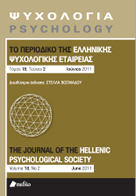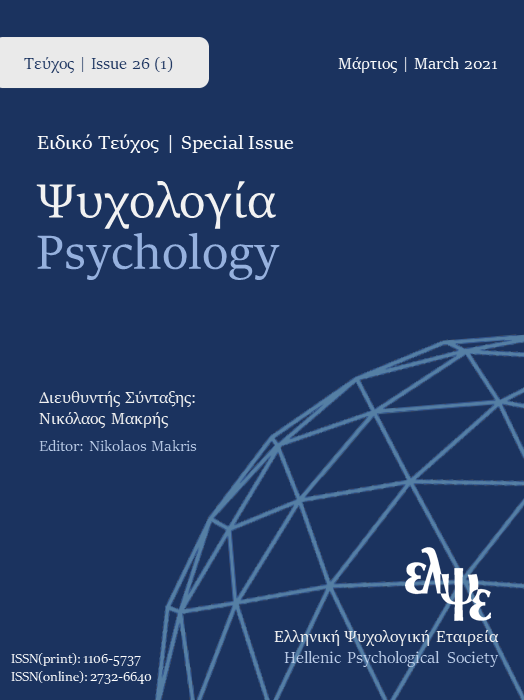Αλληλεπιδρασιακές σχέσεις μεταξύ χρόνου, μουσικής και συναισθήματος

Περίληψη
Το συναισθηματικό περιεχόμενο της πληροφορίας επηρεάζει, μέσω της υποκειμενικοποίησης, την ικανότητα αντίληψης και εκτίμησης της χρονικής διάρκειας (συστολή ή διαστολή της χρονικής διάρκειας γεγονότων ευχάριστης ή δυσάρεστης συναισθηματικής χροιάς, αντίστοιχα). Γνωρίζουμε επίσης ότι η εκτίμηση της χρονικής διάρκειας
των μουσικών κομματιών επηρεάζεται από τη μουσική εμπειρία, με τους μουσικούς να κάνουν ακριβέστερες εκτιμήσεις από τους μη μουσικούς. Τέλος, είναι γνωστό ότι η μουσική επηρεάζει τη διάθεσή μας και ότι η σχέση μουσικής-συναισθήματος εξαρτάται από παράγοντες που αφορούν χαρακτηριστικά τόσο της μουσικής όσο και του ακροατή. Ωστόσο, εκτός από τις επιμέρους αυτές δυαδικές σχέσεις, δεν γνωρίζουμε εάν οι τρεις παράμετροι συνδέονται μεταξύ τους με τρόπο αλληλεπιδρασιακό και ποιος είναι αυτός. Η παρούσα μελέτη επιχειρεί να διερευνήσει και να περιγράψει μια τέτοια πιθανή σχέση. Όπως δείχνουν μελέτες από το χώρο των νευροεπιστημών, όταν ακούν μουσική άτομα χωρίς μουσική εκπαίδευση, ενεργοποιείται το δεξί εγκεφαλικό τους ημισφαίριο, ενώ όταν πρόκειται για άτομα με μουσική εκπαίδευση, ενεργοποιείται το αριστερό. Καθώς η δεξιά εγκεφαλική περιοχή συνδέεται με την αναγνώριση και την έκφραση συναισθημάτων, η ενεργοποίησή της είναι ενδεικτική μιας γνωστικής επεξεργασίας βασισμένης στη συναισθηματική χροιά της πληροφορίας. Φαίνεται λοιπόν ότι η μουσική εμπειρία επηρεάζει το συναίσθημα (παρεμβαίνοντας στη διάθεση), το οποίο με τη σειρά του επηρεάζει την ακρίβεια της χρονικής εκτίμησης.
Λεπτομέρειες άρθρου
- Πώς να δημιουργήσετε Αναφορές
-
Samartzi, S., & Panagiotidi, M. (2020). Αλληλεπιδρασιακές σχέσεις μεταξύ χρόνου, μουσικής και συναισθήματος. Ψυχολογία: το περιοδικό της Ελληνικής Ψυχολογικής Εταιρείας, 18(1), 104–116. https://doi.org/10.12681/psy_hps.23711
- Τεύχος
- Τόμ. 18 Αρ. 1 (2011)
- Ενότητα
- ΘΕΩΡΗΤΙΚΕΣ ΑΝΑΣΚΟΠΗΣΕΙΣ

Αυτή η εργασία είναι αδειοδοτημένη υπό το Creative Commons Attribution-ShareAlike 4.0 International License.
Το περιοδικό ΨΥΧΟΛΟΓΙΑ έχει υιοθετήσει μία πολιτική Platinum open-access. Τα έξοδα υποβολής, επεξεργασίας ή δημοσίευσης των εργασιών καλύπτονται από την Ελληνική Ψυχολογική Εταιρεία. Τα πνευματικά δικαιώματα των δημοσιευμένων εργασιών προστατεύονται από την άδεια 'Creative Commons Attribution-ShareAlike 4.0 International'. Οι Συγγραφείς διατηρούν τα Πνευματικά Δικαιώματα και χορηγούν στο περιοδικό το δικαίωμα της πρώτης δημοσίευσης. Η άδεια αυτή επιτρέπει σε τρίτους, να χρησιμοποιούν την εργασία σε οποιαδήποτε μορφή, με την προϋπόθεση της διατήρησης των διατυπώσεων που προβλέπονται στην άδεια σχετικά με την αναφορά στον αρχικό δημιουργό και την αρχική δημοσίευση στο περιοδικό ΨΥΧΟΛΟΓΙΑ. Επιπλέον, κάθε διανομή της εργασίας οφείλει να γίνεται με τους ίδιους όρους διανομής, δηλαδή με την ίδια άδεια Creative Commons.




